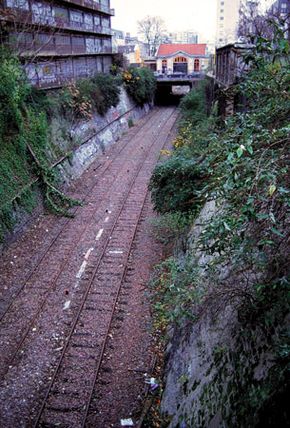
Back Železniční trať Petite Ceinture Czech Chemin de Fer de Petite Ceinture German Fervojo Petite Ceinture Esperanto Línea de Petite Ceinture Spanish Petite Ceinture Finnish Ligne de Petite Ceinture French Ferrovia della Petite Ceinture Italian プティト・サンチュール Japanese Petite Ceinture Dutch Petite Ceinture Portuguese

Paris's former Chemin de fer de Petite Ceinture (French pronunciation: [ʃəmɛ̃ də fɛʁ də pətit sɛ̃tyʁ], 'small(er) belt railway'), also colloquially known as La Petite Ceinture, was a circular railway built as a means to supply the city's fortification walls, and as a means of transporting merchandise and passengers between the major rail-company stations in Paris. Beginning as two distinct 'Ceinture Syndicate' freight and 'Paris-Auteuil' passenger lines from 1851, they formed an arc that surrounded the northern two thirds of Paris, an arc that would become a full circle of rail around the capital when its third Ceinture Rive Gauche section was built in 1867.
Although the Syndicate-owned portion of the line was freight-only in its first years, after the creation of a passenger service from 1862, the Chemin de fer de Ceinture became Paris's first metro-like urban transport, and even more so after the 'Ceinture Rive Gauche' passenger-and-freight section began. The line's passenger service was a popular means of public transport until its 1900 Universal Exposition peak-traffic year.
Paris's first Metro line opened that year and, after that, the numbers of people using the Petite Ceinture passenger service dropped steadily until its closure in 1934. Although maintained as a freight line, even that use of the Petite Ceinture had come to a practical end by the 1980s.
Since then, sections of the Petite Ceinture's trenches and infrastructure have been rehabilitated and renovated for the inter-urban RER C passenger transport service, and some of its former stations have been sold to local commerce and services. The future of the remaining stretches of Petite Ceinture has always been, and still is, the source of much debate.